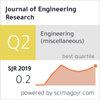SCAMORSA-1: A camber-morphing wind turbine blade with sliding composite skin
IF 0.9
4区 工程技术
Q3 ENGINEERING, MULTIDISCIPLINARY
引用次数: 0
Abstract
Wind turbines form an increasingly important source of renewable and sustainable energy. Traditional rigid wind turbine blades are unable to control the flow of air over their surfaces, resulting in higher loads and lower aerodynamic efficiency at non-optimal wind speeds and angles of attack. This paper presents the design of SCAMORSA-1 (“Sliding CAmber- MORphing Skin Action”), a camber-morphing turbine blade in a small scale Horizontal Axis Wind Turbine (HAWT) for increased aerodynamic efficiency and improved extreme load alleviation. The blade is linearly tapered and comprises three sections: a conventional rigid section, a morphing section, and a fixed blade tip, all covered by functionally graded composite skin. Measured from the root, the rigid section spans 0%-60% of the total blade length and its profile transitions at 20% from SD7062 thick airfoil to the thinner SD7037 airfoil. The rigid section includes carbon fiber composite spars that resist flap-wise bending. The morphing section occupies the next 30% of the span with SD2030 airfoil profile and can seamlessly change camber angle up to 10°. This section is composed of three hybrid ribs connected via two leading-edge composite spars and a trailing-edge synchronizing rod. Each hybrid rib has a solid leading-edge segment connected to a flexible trailing-edge segment via T-slots. The trailing-edge segment, where morphing occurs, is an enhanced version of the corrugated FishBAC design, with hexagonal honeycomb infill that increases the out-of-plane stiffness and allows for morphing deformation without internal buckling. Two of these hybrid ribs have servomotors housed in the leading-edge segment. These integrated actuators in the hybrid ribs actuate flexible carbon fiber ribbons that run through slits in the trailing-edge segment to morph it. At the trailing-edge portion of the morphing section, the composite skin transitions to a thin flexible layer that can slide over the deforming trailing-edge segment via skin sliders. Computational simulations were performed to quantify the performance gains and ensure safe operation of all components. A proof-of-concept model of SCAMORSA-1’s morphing section was manufactured and tested to demonstrate the effectiveness of the design.
SCAMORSA-1:带滑动复合材料蒙皮的外倾变形风力涡轮叶片
本文章由计算机程序翻译,如有差异,请以英文原文为准。
求助全文
约1分钟内获得全文
求助全文
来源期刊

Journal of Engineering Research
ENGINEERING, MULTIDISCIPLINARY-
CiteScore
1.60
自引率
10.00%
发文量
181
审稿时长
20 weeks
期刊介绍:
Journal of Engineering Research (JER) is a international, peer reviewed journal which publishes full length original research papers, reviews, case studies related to all areas of Engineering such as: Civil, Mechanical, Industrial, Electrical, Computer, Chemical, Petroleum, Aerospace, Architectural, Biomedical, Coastal, Environmental, Marine & Ocean, Metallurgical & Materials, software, Surveying, Systems and Manufacturing Engineering. In particular, JER focuses on innovative approaches and methods that contribute to solving the environmental and manufacturing problems, which exist primarily in the Arabian Gulf region and the Middle East countries. Kuwait University used to publish the Journal "Kuwait Journal of Science and Engineering" (ISSN: 1024-8684), which included Science and Engineering articles since 1974. In 2011 the decision was taken to split KJSE into two independent Journals - "Journal of Engineering Research "(JER) and "Kuwait Journal of Science" (KJS).
 求助内容:
求助内容: 应助结果提醒方式:
应助结果提醒方式:


